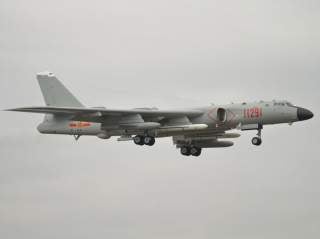Almost a War?: Russian and Chinese Planes Violated South Korean Airspace
Here's what happened.
Intrusions into East China Sea airspace claimed by both China and Japan are fairly common — even sometimes involving South Korea.
What Happened
An odd set of confrontations unfolded July 23 around the Korean Peninsula involving South Korea, Russia, China and Japan. According to an official South Korean account of the events, early on July 23, two Chinese H-6 bombers entered South Korea's Air Defense Identification Zone (ADIZ) near Ieodo, a submerged rock claimed by both South Korea and China in the Yellow Sea. They later entered the ADIZ once again at Ulleung island off South Korea's east coast in the Sea of Japan before being joined by Russian TU-50 bombers and re-entering the ADIZ for a third time. After this, a Russian A-50 early warning aircraft and two Tu-95 bombers entered the ADIZ around Dokdo Island — a maritime space that Japan also claims as the Takeshima Islands — before the A-50 passed into South Korean-claimed airspace, leaving it and then reentering it again. South Korea scrambled jets to respond to both alleged entries by the A-50, firing both warning shots and flares.
Moscow, on the other hand, insists its aircraft did not impinge on any country's airspace and that their movement was part of a maiden joint long-range Sino-Russian patrol that had been previously scheduled to overfly international waters in the Sea of Japan and the East China Sea. Russia also underscored that it does not recognize the South Korean-declared ADIZ. South Korea filed formal diplomatic protests with Russia over the incidents. Japan followed suit, saying the Russian and Chinese bombers entered Japan's ADIZ in the East China Sea and that it had also scrambled jets in response. Tokyo also specifically condemned both South Korea and Russia for the actions in its airspace.
What It Could Mean
The anomalous series of events raises several questions. Intrusions into East China Sea airspace claimed by both China and Japan are fairly common — even sometimes involving South Korea. While the Japanese routinely scramble aircraft to counter East China Sea intrusions, it's unusual to see Russian aircraft in the area near South Korea in which the July 23 incident took place, making this encounter the first of its kind.
While a navigational error due to human error or equipment malfunction could have sent Russia's A-50 over Dokdo, the Russian flight path reported by South Korea shows a fairly tight loop around the disputed feature, raising the possibility that the Russian pilot's course was deliberate. Even if accidental, the Sino-Russian joint exercise and other ongoing activities highlight that infractions will inevitably become more frequent as Russia and China continue to increase aerial patrols in the airspace over the Sea of Japan, raising the risk that further incidents will occur. If it was an intentional act, the aircraft's entry into South Korea's claimed airspace would be both a brazen and risky maneuver, raising questions about Russia's intent — and, in the broader context of the joint exercise, perhaps China's as well. Notably, the alleged Chinese entry into South Korea's ADIZ was limited to Ieodo, a feature that China also claims and the site of frequent challenges to South Korean claims.
South Korea's response was also unusually vehement — warning shots are rarely part of such an interception. For South Korea, the passage through the airspace around Dokdo is particularly troublesome given that the land feature there is its anchor in its efforts to extend its ADIZ to the northeast. That this was part of long-planned Russia-China joint patrols that included incursions in other corners of the ADIZ is doubly concerning for Seoul. It also marks an actual Russian flight over South Korean-claimed airspace — which is of much greater significance than an ADIZ fly-through.
Background
This series of incidents, which comes amid greater alignment between Russia and China in the Asia-Pacific, echoes an apparently coordinated action between the two countries in 2016 to sail through Japanese-claimed waters in the East China Sea around the Senkaku/Diaoyu islands. The Dokdo/Takeshima incident also comes amid a dispute between South Korea and Japan that has morphed into a low-level trade war — providing increased incentive for South Korea to underscore its sovereignty over the disputed geographical features.
South Korea, Russia: What to Make of a Midair Interception Over Disputed Waters is republished with the permission of Stratfor Worldview, a geopolitical intelligence and advisory firm.
Image: Wikimedia

